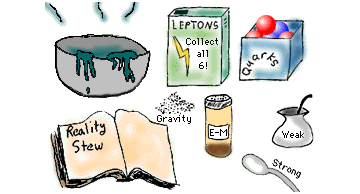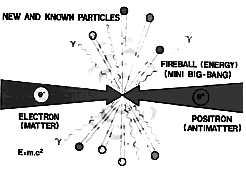

Particles and the Universe (Prof. Peter Kalmus)
Teaching Particle Physics - Oundle School site.
Basic Particle Physics for Microcosm.
Taken from Politics, Solid State and the Higgs By David Miller. Department of Physics and Astronomy, University College, London, UK.
Imagine a cocktail party of political party workers who are uniformly distributed across the floor, all talking to their nearest neighbours. The ex-Prime Minister enters and crosses the room. All of the workers in her neighbourhood are strongly attracted to her and cluster round her. As she moves she attracts the people she comes close to, while the ones she has left return to their even spacing. Because of the knot of people always clustered around her she acquires a greater mass than normal, that is she has more momentum for the same speed of movement across the room. Once moving she is hard to stop, and once stopped she is harder to get moving again because the clustering process has to be restarted. In three dimensions, and with the complications of relativity, this is the Higgs mechanism. In order to give particles mass, a background field is invented which becomes locally distorted whenever a particle moves through it. The distortion - the clustering of the field around the particle - generates the particle's mass. The idea comes directly from the physics of solids. Instead of a field spread throughout all space a solid contains a lattice of positively charged crystal atoms. When an electron moves through the lattice the atoms are attracted to it, causing the electron's effective mass to be as much as 40 times bigger than the mass of a free electron. The postulated Higgs field in the vacuum is a sort of hypothetical lattice which fills our Universe. We need it because otherwise we cannot explain why the Z and W particles which carry the weak interactions are so heavy while the photon which carries electromagnetic forces is massless.
Now consider a rumour passing through our room full of uniformly spread
political workers. Those near the door hear of it first and cluster together to get the
details, then they turn and move closer to their next neighbours who want to know
about it too. A wave of clustering passes through the room. It may spread to all the
corners or it may form a compact bunch which carries the news along a line of workers from
the door to some dignitary at the other side of the room. Since the information is
carried by clusters of people, and since it was clustering that gave extra mass to the
ex-Prime Minister, then the rumour-carrying clusters also have mass. The Higgs
boson is predicted to be just such a clustering in the Higgs field. We will find it much
mechanism for giving other particles is true, if we actually see the Higgs particle
itself. Again, there are analogies in the physics of solids. A crystal lattice can carry
waves of clustering without needing an electron to move and attract the atoms. These
waves can behave as if they are particles. They are called phonons and they too are
bosons. There could be a Higgs mechanism, and a Higgs field throughout our Universe,
without there being a Higgs boson. The next generation of colliders will sort this out.
The world of sub-atomic particles is rather different to the large scale one which we are used to. Some of the ideas may sound ridiculous at first.
Possibly the most famous scientific equation of all time is that
established by Einstein.
![]()
![]()
This implies two important ideas.
1. Mass and energy can be converted to and from each other. Particles can convert to energy, either completely or, as with nuclear fission, partly; the mass decrease becomes energy. This can happen in reverse, and in a machine like the CERN the process involves mass » energy » mass. The trick is that the new mass appears spontaneously as different, and hopefully unusual, particles.
A particle is therefore can be described both as energy and as mass -
the two ideas are unavoidably intermixed. 
2. The equation also tells us how much energy. Because c (the speed of
light) is a huge number, and in the equation it is squared as well, then tiny bits of mass
become vast amounts of energy and vice versa. If a thimble of water could be converted
totally into energy (which it cannot), then the energy would keep Switzerland supplied
with electricity for six hours! 
It then seems sensible that instead of having different units for mass and energy, we have just one. The energy unit is used, but because we are dealing with tiny bits of atoms rather than drops of water, the joule is too large. The unit is the electron volt. 1 electron volt (eV) = 10-19 J approx.
At the CERN you will see energies measured in GeV (that is, 1 000 000 000 eV), even TeV (1000 times higher), which, for tiny particles like protons, electrons etc, are truly enormous. Whilst the energy is small by the standards of our large scale world, at the CERN it is highly concentrated and the results are startling. This mass-energy equivalence also has implications for stability. Protons, neutrons and electrons are common because they are stable. They are stable because they are the lightest form of their type of particle. The electron can have spontaneously changed from something, with a decrease of mass and an output of energy. But increase of mass, requiring an input of energy, can only occur with great difficulty. That is the role of the particle accelerator.
Every property of matter is the opposite with antimatter, except for mass. Thus the (negative) electron has an antiparticle called the positron (positive electron) which has exactly the same quantity of charge, but positive. The masses of the two particles are not opposite but are identical. Since mass and charge are not the only properties of a particle (there are others such as spin), neutral particles like the neutron can have an antimatter partner. An unstable particle has exactly the same half life as its antiparticle opposite, and will decay in exactly the same way. When a particle collides with its antiparticle then the two are instantly converted totally into energy. It follows that in our world today antimatter must be very rare indeed. What antimatter may once have existed naturally must have been converted to energy long ago as it interacted with ordinary matter.
The large accelerator ring at CERN called LEP (Large Electron Positron
collider) needs antimatter to work which has to be manufactured and accelerated, but kept
away from the matter until the collision is made to happen. If an electron is held in a
circular path by a magnetic field, then the positron must travel the opposite way to stay
in the same circle, because it has the opposite charge. The force needed to pull these
particles into the circle is simply the motor force - a magnetic field interacting with a
current, and a current is made of charges in motion. The two types of particle - electrons
and positrons - follow a slightly different path until they are made to collide. 
The collisions are made to happen at four sites around the ring. The pure energy created then immediately converts itself into many particles and their energy, most of which are not found in nature today, which are observed in huge detectors weighing thousands of tonnes. However we do believe that the particles did once exist naturally, right back at the creation of our Universe.
Einsteins equation quoted above came from his theory of relativity which also says that:
1. Nothing can travel faster than the speed of light.
2. The mass of an object increases as it gets faster. The everyday speeds that we experience, even in an aeroplane, are far too small for this to show up. But at, say, 50% of the speed of light, then it begins to matter a lot. At the speed of light the mass would be infinite. Since this is impossible, no particle can go this fast. This is a consequence of the limit set by the speed of light. An increase of KE means that both v and m increase. At low speeds - speeds within our normal experience - m hardly changes and only v increases significantly. But as v gets larger, then m will begin to increase measurably, and v will increase less so. Near the speed of light, v hardly changes at all (because it cant get much bigger - it saturates) and the increase in KE is almost purely seen as an increase of mass.
There are four forces of nature that act at a distance - that is, set up a field. The electric and gravitational fields we observe in the large scale world of planets and tumble driers. The other two are two nuclear forces that only occur on the subatomic scale. The word force is a bit misleading; interaction is perhaps better. Strong force.

If protons repel each other due to the electric force (like charges repel), how come they stay together in the nucleus? And how do neutral neutrons stay put anyway? There must be a strong force that defeats repulsion at these short distances, but is of very limited range because we do not observe it outside the nucleus. The strong force is in fact even stronger than that; it is the force that holds the constituents of protons, neutrons and the like to each other, the quarks. What holds the protons and neutrons together is the residue of this force, similar to the hydrogen bond of the water molecule; this molecule is electrically neutral but can still interact electrically and exert a force.
The range of the residual strong force is about the same as the diameter of the nucleus. If a nucleus is of large diameter (high atomic number) then the components start to lose touch with each other and the cluster becomes unstable, all the more so because of the increasing and long range electric repulsion between protons. Lead (82 protons) forms the largest stable nucleus.
Unlike the familiar electric and gravitational forces, the strong force between quarks increases with separation so quarks cannot escape and have no independentexistence; they can only be observed indirectly. Weak force.

The weak force is weird, partly because we think of a force in terms of pushes and pulls, and newtons. At the microscopic level we are really mean is the likelihood of an interaction. If two particles are likely to interact then the force - that is, the probability of interaction - is strong. If the interaction is unlikely, then it is a weak force interaction. Weak force particles cannot be sensitive to the strong force, otherwise the weak force would be swamped out. Electrons do not experience the strong force, only the weak force, and are not made of quarks.
In ß decay a neutron decays to a proton and an electron (plus an antineutrino) with a half life of about 10 minutes, far too slow for a strong force interaction, and a reason that the weak interaction was suggested. This is abnormally large, and a typical lifetime of a weak decay would be 10-8 seconds, as compared with 10-20 seconds for the strong force.
The weakness - rareness - of the interaction explains why the Sun burns
as slowly as it does. If the fusion process involved only strong - frequent -
interactions, then our star would be long gone by now... 
Beta particles have varying amounts of energy even though they have the same origin; cloud chamber tracks clearly show a whole spread of ranges in air. There must be an extra particle, very difficult to detect because we dont notice it, which carries some energy so that the total energy per event is constant. This particle is the antineutrino, which has no charge, and mass too small yet to be found, possibly zero. This makes it difficult to find (it took roughly 30 years from prediction to discovery) and is an example of a particle other than the proton/neutron/electron group, a glimpse that all is not as simple as it might be.
Once you start looking for or manufacture particles, the variety gets
absurdly large; several hundred have been discovered. This is unsatisfactory, and the
scientists gut feeling is that this cannot be. This level of disorganisation is wrong. The
Universe cannot be made up of a random bunch of odd and ephemeral particles. 
The situation is comparable with that of the chemical elements, organised into the periodic table by Mendeleev. Whilst there are 92 natural elements, these show a pattern of behaviour (for example all the noble gases - argon, neon etc -show similar properties) and this arrangement can be related in a simple way to various combinations of just three particles; protons, neutrons and electrons. This simple model of the atom is fine for explaining many things such as chemical reactions, line spectra and so on. These three familiar particles - proton, electron, neutron - are not the whole picture. There must be an analogous pattern that relates all these exotic particles.
This pattern is the standard model; matter is seen as made up of three
groups of particles. Quarks.
Leptons.
Bosons.
Quarks.
These never occur singly but combine in twos (to make mesons) or threes
(to make baryons, which include protons and neutrons). An allowed combination ofquarks is
a hadron - that is mesons and baryons together. 
Each quark carries fractional charge of +2/3 or -1/3 units as compared with the electron, with antiquarks oppositely charged. The resulting particle has ±1 or zero charge (for example two quarks at +2/3 and one at -1/3 will total 1 unit of charge. To make ±1 or zero charge with just two quarks, then one has to be an antiquark - for example a combination of +2/3 and +1/3 - the second has the wrong sign of charge and so is antimatter; hence mesons are not found naturally today). Quarks combine by the strong force, the resulting hadrons binding by residual strong force to form nuclei. When a nucleus changes, as in b decay where an electron and an antineutrino are emitted, the quarks change as well. Quarks are thought to be indivisible and are never seen alone - their existence can only be inferred.
There are three pairs of quarks, each with an antiquark. The lightest (most stable) are the only ones occurring naturally today, called up and down. The heaviest (called top) was so huge - lots of energy required to make it and highly unstable - that it was only discovered in 1994. Leptons.
Unlike the hadrons, these are not made of anything smaller. Because
there are no quarks, they do not experience the strong force. They can be found alone.
Electrons are leptons, which along with the neutrino are the only ones in ordinary matter.
There are two others each with their neutrino - 6 in total - plus their antiparticles. 
Bosons.
These are the carriers (messengers) of the four fundamental forces. It seems obvious - because we are so used to it - that electric forces act at a distance. Indeed they do, but how does a positive charge know that there is a negative charge nearby producing an attractive force? How does the Earth know that there is a plane flying at 35,000 feet which must experience the force of gravity? Surely it would almost be more obvious if you kept going on up when you jumped into the air! Field type forces act without normal contact so there must be some form of communication. On the other hand, someone punching you on the nose would not involve a boson, because contact has to be made before pain occurs.
There are four interactions (gravitation, electromagnetic, weak and strong), therefore four groups of boson.
In the 19thC. Maxwell established a theory relating the electric and magnetic forces. Glashow, Salam and Weinburg published the electroweak theory in 1971 to include the weak force as well. The ultimate aim is to join all the interactions together into a single theory. It is believed that in the first fractions of a second in the life of the universe all the forces were as one, so there is good reason to believe that finding a single unifying theory is viable.
range/m |
rel.strength |
|
strong: |
10-15 |
102 |
electromagnetic: |
infinity |
1 |
weak: |
10-18 |
10-3 |
gravitational: |
infinity |
10-36 |
For diagrams look at the CERN photo collection at
weblib.cern.ch/weblib2/Home/Media/Photos/CERN_PhotoLab/?freetext1=
and select 'Diagrams and Charts' and then type in 'standard model'.
Bosons and mass.
Since there are four fundamental forces, there are four associated types of boson.
Strong. Gluon (8 types).
Weak. W+, W - & Z0.
Electromagnetic. Photon.
Gravitation. Graviton.
Of these the only one familiar to us is the photon - although the conjectural graviton would also be part of our world. The photon has zero mass (probably) and so is the ultimate in stability; it can have no further decrease in mass if it already has none! Hence the range is infinite because the particle does not decay; it just keeps on going. Gravity is of infinite range, so the graviton would also be massless.
A proton has around it a field - attraction or repulsion at a distance. In terms of bosons the proton continually creates and absorbs photon messengers; this the mechanism of the field. If this proton encounters, for example, a positron with its own dynamic haze of photons then a photon is transferred from the positron to the proton. Due to momentum changes, the positron recoils from the proton and vice versa. The effect is repulsion. The photon involved did not exist before the interaction, and does not exist afterwards. Indeed the only evidence that it ever existed is the momentum and energy changes of the two particles. This photon cannot be detected directly by any experiment , only deduced from the results, and so is called a virtual photon. Some photons are very real, like those coming from a light, because they continue to exist after the interaction is finished; otherwise a light bulb would not emit light! An electron-positron annihilation yields two real photons, and a virtual photon within the process.
The aptly named strong force gluons, and the less interestingly named weak force W and Z, are very short range bosons; they exist only in the nucleus. The residual strong force is transmitted by pions . The weak force boson may or may not involve a change in charge in the interaction; hence the need for three (W+, W- and Z0 - the 'O' means neutral).
Pions and weak force bosons have mass; the mass of these weak force bosons is 80 to 90 times more than that of a proton (the proton is about 1GeV). This is odd; such huge numbers do not figure in calculations of atomic mass such as you might use regularly in chemistry.
The reasoning is as follows. Extremely short range implies that the particle has minimal stability which in turn (see above) implies a large mass. Within its own frame of reference any particle can be considered to be at rest (because there is no way of defining absolute motion). Thus the emitted boson energy violates mass-energy conservation, but providing the boson transfers quickly enough, then borrowing energy like this is allowed. (It is a bit like using an American Express card; money is borrowed to pay for things, but must be paid back by the end of the month, before the bank notices as it were.) The mass-energy evolves from the uncertainty principle of quantum mechanics. Unlikely though it may seem, this principle allows particles to have any mass you like within a certain range, provided they exist for a tiny fraction of a second. The longer you look for, or try to measure, the mass, the more precisely defined will it become. Providing the W or Z0 boson is quick enough in flitting from particle to particle, nature does not have time to see it properly and the mass is open to a considerable degree of uncertainty. The distance is tiny, the time very brief.
The relationship is that
energy borrowed x time <= Plancks constant
where the energy borrowed is given by Einsteins relation. Recalling that
distance = ct
and after a bit of very simple algebra, you will find that the maximum range is given by
distance = h/mc
Consequently an uncertainty in mass of 1 GeV can exist for up to 10-24 seconds, so with a mass/energy of around 80 to 100 GeV (10-26 seconds) giving 3x10-18m at the speed of light for electroweak bosons there is no chance of finding them outside the nucleus under normal conditions. Real bosons should be produced as the result of very high energy collisions. The bosons would decay before they could be observed, but their decay products are predictable, a matter-antimatter pair, and these could be detected. Thus any electroweak boson that could be found would show up because of what it became, rather than what it was. For example theneutral Z0 boson can become an electron/positron pair; both are charged particles and so readily identified. To dig the gluon out of the nucleus would require massive energies, beyond current technology.
When masses slam together at huge kinetic energies, pure energy is formed in line with Einsteins equation, which in turn converts to new particles (including bosons) and their kinetic energies. The bigger the initial kinetic energy, then potentially the bigger the masses of the products. Alternatively, using the de Broglie relationship
wavekength = h/p where p = momentum
then high velocity means high momentum, and short wavelength. Basic diffraction says that we cannot see an object small than the wavelength we are using, so to see really small objects - like inside the nucleus - we must use wavelengths of maybe 10-18m; very high energy.
There are three ways of increasing the input of kinetic energy:
make the initial particles go faster.
make the initial particles more massive.
make the initial particles collide head-on.
The accelerator can be longer. The longer it is, the faster the
particles can go, and they also gain mass in line with relativity. In a straight line this
is limited, but if the path is circular effectively the particles are moving along a tube
of infinite length. Or the particles can have a bigger rest mass to start with. To make
the particles move in a circle, they have to be pushed magnetically. The faster and the
more massive, the harder the push has to be. For electrons near the speed of light in the
LEP the field is about 0.07T, about the same as a fairly strong permanent magnet. The LHC
(about to be built) will use more massive protons and fields of around 10T will be
required, far in excess of routine technology. To make particles collide head on, there
must be two, of opposite charge. But so as they will be controlled by the same magnetic
field, charge must be the only difference. Hence antimatter. 
There are two principles which apply to all instruments.
Firstly you have to see where the particle has been. You may have seen a cloud chamber, where alpha particles leave straight condensation trails. Particles can be distinguished in part by their range - again think of basic radioactivity and the absorption of different types of radiation. In particle physics the range is also limited by the extremely short life of some particles.
Secondly you need to make measurements. With charged particles it is possible to find their momentum by passing them perpendicular to a magnetic field, momentum being deduced from the curvature of the path. In many pictures you will see curves and spirals. Particles that are uncharged - which includes photons - will travel straight, but because they rarely interact with matter they leave no trace until they do interact or decay (indeed neutrinos generally pass straight through the Earth! They are essentially never detected directly). Particles that are charged but have very high kinetic energy will travel almost straight and leave a trace. A charged particle of low KE will produce a tight spiral, or a smaller circle (which shape it is depends on the type of detector).
A relative of the cloud chamber is the bubble chamber, where the charged particles leave trails of bubbles inside a large tank of superheated liquid which can then be photographed, which is where the picture above came from (there is a redundant bubble chamber which you can see behind the reception desk at Microcosm, looking like something straight out of Flash Gordon!). The problem with all these devices is that they are slow, requiring the physicists eye for analysis, photograph by photograph. CERN is looking for events so rare - maybe one event out of hundreds of thousands - that this is simply not practical, and the data has to be logged and processed automatically, requiring huge computers. The physicist only looks at relevant events selected for him by the computer. Modern detectors look for ionisation in a way that be converted to an electrical signal which can be logged. For example high energy photons will create ions in special types of glass, producing in turn a shower of light (visible photons) which can then be detected electronically. The spark counter, cloud chamber and Geiger-Muller tube also all depend on ionisation.
The term calorimeter crops up. You may recall that this may be a copper container or suchlike used in specific heat capacity experiments. The term calorie is an old unit of energy (sometimes still used for dietary purposes) and so any energy measuring device is a calorimeter. The fact that it may not measure thermal energies, be the size of a house and cost the odd few £million is neither here nor there.
For pictures of detectors and events look at the CERN photo collection
at
weblib.cern.ch/weblib2/Home/Media/Photos/CERN_PhotoLab/?freetext1=
and select 'Experiments and Tracks' and leave the 'search' box empty.
This is the science of measuring radiation exposure and protecting people from it so that they stay within safe exposure limits. As a rule-of-thumb these safe limits are set at half what is thought to be dangerous to health.
CERN is a radiation risk area. For example, when the accelertor beams are switched on, the tunnels are closed and bolted and the system will automatically shut down if the doors are opened.
Substantially the radiation is contained by the fabric of the tunnel. The level of radiation experienced by a visitor is extremely low and of no significant danger as compared with the background radiation we all receive every day.. However for workers at CERN who may spend their working time in these areas it is necessary to monitor radiation levels and to have their own exposure checked using film badges; you will also find other types of radiation detector spread around the experimental areas which measure environmental radiation levels.
In much the same way the radiation experienced by having a single chest X-ray or a teeth x-ray is minimal, but for those operating the machinery day after day the risks are much higher unless sensible precautions are taken.
There is a Department at CERN whose job is radiation safety.
For measuring the exposure two quantities are used, the DOSE and the DOSE EQUIVALENT.
DOSE is the energy absorbed per unit mass. Unit: Gray (Gy)
1 Gy = 1 J/kg
Lethal dose is between 1 Gy and 10 Gy depending on the type of radiation.
There exists a biological recovery factor to photon radiation (i.e. gamma rays). This is because biological systems can repair (some) of the damage caused by gamma rays, but generally not the damage caused by alpha particles or beta particles.
Dose rate (Gy/min) can also affect the outcome.
Effects on Humans.
| DOSE (Gy) | Life Expectancy | System damaged |
| 1000 | 1 hour | Central Nervous System |
| 10 - 100 | 3 days | Gastrointestinal Tract |
| 3 - 10 | 30 days | Bone Marrow |
| < 1 | > 10 years | Cancer risk |
DOSE EQUIVALENT is the effective dose an organism receives, taking into account the differing biological effects of different types of radiation. Unit: Sieverts (Sv)
Dose Equivalent = Dose x Q
Q is the Quality Factor and depends on the radiation type, dose rate and biological type involved.
Q is the most difficult thing to measure in radiation protection.
Typically, alpha particles have Q = 20, for neutrons Q = 10, and beta particles and gamma rays have Q = 1.
Background dose equivalent is in the range of 1 to 2.5 mSv per year depending on location. Professional workers in radiation 'hot' environments are limited to 15 mSv per year (CERN, 1999).
Radiation damage can add to existing risks (if it affects the DNA), or, it can multiply existing risks (if it affects the immune system).
RADIATION PROTECTION MEASURES ARE VERY
EFFECTIVE.
IN TOTAL ONLY AROUND 600 PEOPLE IN THE WHOLE WORLD HAVE EVER DIED
FROM DIRECT RADIATION CAUSES.
| Contact: Hanley@southbridge.demon.co.uk | Last modified: 07.03.00 |
© CERN and High School Teachers Programme at CERN.